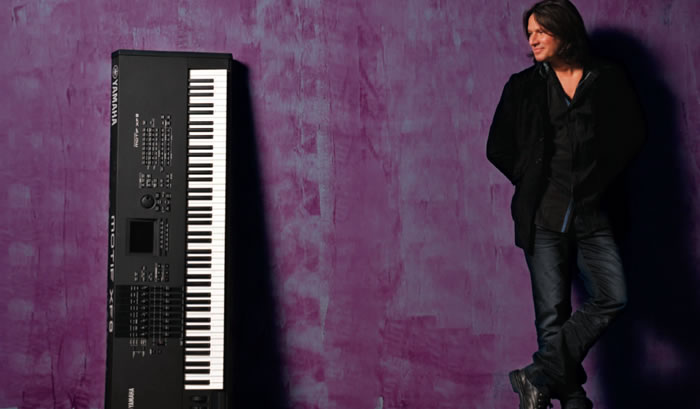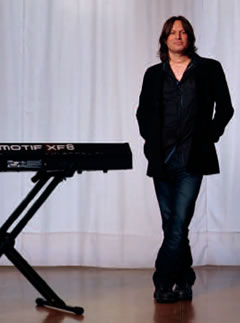


SOLO ARTIST, SONGSMITH, SIDEMAN: Keyboardist and multi-instrumentalist Russ Irwinís musical career has been more like a game of musical chairsóone heís definitely winning.
In 1991, with a debut album produced by Phil Ramone, the 20-year-old Russ seemed destined for the big time. He reached #28 on the Billboard Heatseekers chart with the single, “My Heart Belongs to You,” and toured with his own band. “It took five years until that process was finally done,” he recalls. “But ultimately it just didnít penetrate. Hell of a learning experience, though!”

But Russ was far from done with music. He turned his talents to a second career as a sideman to the stars, performing with such artists as Sting, Bryan Adams, and Aerosmith, with whom heís toured since 1997. “I wasnít even planning on being a side guy,” he says. “I just liked working with people I thought were really talented and being part of their gigs. But this is whatís taken precedence over the past 15 years.”
Between world tours, Irwin was gaining ground with career number three: songwriting. In addition to co-writing songs for artists such as Foreigner, Meatloaf, and the Scorpions, he recently collaborated with Steven Tyler and songwriter/producer Marti Frederiksen on Aerosmithís Adult Top 40 hit, “What Could Have Been Love.”
Working from his studio in Los Angeles, Irwin also found success with yet another career path, producing tracks including Clay Aikenís cover of “I Want to Know What Love Is,” from the former American Idol starís 2006 album AThousand DifferentWays.
The motif has a very realistic piano soundóit really sounds like a grand.
Now Russ is returning to his singer/songwriter roots with the blues-infused Get Me Home, his first solo record in 20 years. The album features guest appearances by several of Irwinís better-known musical friends, including Steven Tyler, guitarist Dean DeLeo of Stone Temple Pilots, and jazz and pop trumpeter Chris Botti.
“I kind of wanted to fill that void, and make a record the way I wanted to 20 years ago,” he explains. “I wanted to get back to why I started playing music in the first place, which is to be inspired and have a good time and try to do something cool. The producerís studio was in this old house in upstate New York, with tons of old instruments, and me and this bass player and a drummer just sat around and jammed. I was writing stuff on this old piano from the 1920s, and it just turned into a record.”
Back in his own studio, Irwinís usual instrument of choice is his Yamaha C5 grand. “I find that I write best on piano,” he says, “just because Iíve studied it so much. I have a pretty wide vocabulary with the piano, and Iíve studied a lot of different styles.”
Irwinís fluency in a broad range of genres also comes in handy in performance, where different acts can demand very different approaches. “People at Sting shows are sitting down, and at Aerosmith concerts theyíre jumping up and down,” he notes. “Steven always wants me to play like Jerry Lee Lewis or Leon Russell, really hit the keyboard and be very bombastic, which is really fun. With Sting it was much more toned-down and sophisticated. It was touching more of what Iíd studied with jazz. It was a totally different hat to wear, a completely different experience.” He laughs. “Almost opposite in a lot of ways!”
Onstage, Russ plays several Yamaha Motifs. “With Aerosmith Iím using an XS7 and an XS8,” he says. “They just have a great sound library. I really got into learning how to program them and map out different sounds across the keyboard. Iím using a lot of string sounds, horn sounds, really organic stuff. And the Motif has a very realistic piano soundóit really sounds like a grand. Whereas I donít find that a lot of other keyboards do.”
He also recently acquired Yamahaís new NP31 Piaggero portable keyboard. “Itís awesomeóitís like my favorite new thing,” Irwin enthuses. “Itís perfect for the road: five octaves, battery powered, itís got speakers, and itís really light. Itís the first time Iíve really been able to practice while Iím on the road.”
Russ may have ventured down many musical paths in his career to date, but theyíve all led to a single destination. “Side guy, artist, songwriter, produceróto me, itís all connected,” he says. “I look at it all as one piece of work, which is just my musical life. With a lot of side guys, there are high highs and then there are low lows. But I really love being around great musicians who are better than me at what they do. I try to surround myself with people that I get inspired by. And I think thatís made a big difference.”
(Photography Credit: Rob Shanahan)
























